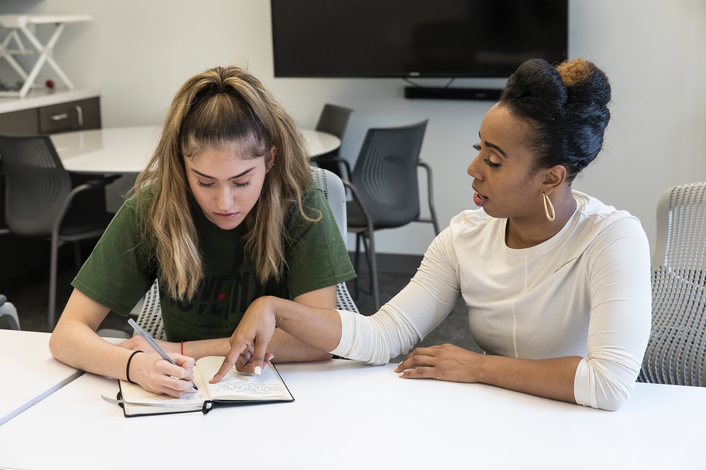
In 2001, young Chanel, a determined, ambitious, fiery, headstrong teenager, was about to begin her sophomore year at LaGuardia High School of Music & Art and Performing Arts, also known as the highly acclaimed “Fame” school. I was a great student, a promising young dancer and well-liked by my teachers and my peers. On paper, everything seemed in order. In reality, this picture-perfect image was fractured. There was a crack that I’ve attempted to hide, cover up and bury for nearly 20 years.
Now, I’m sharing the truth in order to call our community to action. As many know, cases of sexual misconduct involving students plague dance institutions year after year. Reports of those in positions of leadership abusing their power have become commonplace. Sometimes, the stories go back decades.
For 32 of my nearly 35 years, I have had the honor of dedicating my life to dance. And now, in my role as teacher, mentor and co-founder of MOVE|NYC|, I feel the weight of keeping my students out of harm’s way. The thought that one of them could possibly fall victim to the manipulation that so dramatically impacted my life frightens and infuriates me.
With the rise of the #MeToo movement, we have heard of countless cases of sexual misconduct survivors being ignored, dismissed, victim-shamed or, worst of all, punished for speaking up. How can it be that we too—a community that says we believe in the healing power of sharing our stories—are complicit in silencing those abused? How can it be that we—a community that promotes the enrichment and empowerment of young people—turn a blind eye when they come forward in need of safety and protection? How can it be that, after decades of reports, sexual misconduct continues to be an open secret in dance?
While attending LaGuardia, I also studied at a private dance studio, where I received excellent training in multiple genres. There, I also experienced the magic of mentorship. Our teachers were not just our teachers; they became our village. Our family. They challenged us artistically and made it a point to develop personal relationships with us.
Not only did the students trust these teachers, so did our parents. It was commonplace for teachers to drive us home after rehearsal. They mentored us outside of the studio in casual settings, inviting us into their homes and having one-on-one sessions over dinner. Most times these experiences were productive and nurturing. However, one of my teachers took advantage of these opportunities to sexually abuse me.
It first began on what I assumed was a usual Friday night post-rehearsal drop-off. We were in his car, chatting about dance and my continued path as a dancer, and as I was about to get out he leaned over and kissed me.
Looking back, I now recognize that for all my confidence as a 15-year-old, I was so very naïve. I was a child with a child’s understanding of the world, unaware of the extreme power dynamics that underscore the culture of dance education. Like many who find themselves in this situation, I believed I had no power. A belief that was reinforced by my abuser. I thought that if I said anything, I would be blacklisted in the dance community that I desperately wanted to be a part of.
Over two years I fell victim to continued sexual abuse at the hands of this teacher. Even though it never felt right, I kept thinking, If I said no would my teacher not like me anymore? Would all of my opportunities for performances be taken away from me? Will anybody believe me if I speak out?
It became a shameful secret. I was terrified to tell anyone. In a strange and complex twist of emotions, I had been manipulated to believe this man loved me. He was my teacher, my mentor, an accomplished artist. A trusted member of our village. I feared if I said anything, he would go to prison. At the age of 15, that terrified and paralyzed me!
Therapy in my mid-20s helped me see and understand some key truths that were critical to my healing.
First, that at the time of this abuse, I was a minor—a child—who was taken advantage of.
Second, my trusted teacher, recognizing my vulnerability and inexperience, used his power of both position and maturity to manipulate me.
Lastly, what happened to me was not my fault. This insight helped me to let go of the shame I’ve carried for nearly two decades.
It wasn’t until 2018, at the age of 32, that I had the courage to finally speak up. I was having a catch-up lunch with another of my former teachers who had been a part of my dance training “village.” He was now in business with my abuser, having founded a new dance school. Struck by the realization that this man, my abuser, was now in an even more powerful position—and still holding sway over impressionable young dancers—I began to share my story. I needed my former teacher to know the character of his business partner and what he might be capable of.
He was stunned. After much discussion, we agreed this had to be addressed. Although I was fearful about the potential harm to my reputation, I decided it was time for my experience to come to light so that, hopefully, other students would not share my fate.
In the fall of 2019, I relayed my story privately to the board of directors of his new dance school. My intention was to offer my testimony of what happened so that they would take preventive measures. Yet to my surprise and disappointment, at the time of this writing, my abuser remains in his position.
Unfortunately, my story is not unusual. A Google search of “sexual misconduct in dance” shows that I was not the first in the dance community to fall victim to sexual misconduct and was indeed not the last. Now in a position where young people look to me for guidance, I believe it is my duty to create a safe environment for them to thrive.
Our students deserve to train, grow and evolve without harm. They should never have to be afraid of being shunned for not succumbing to immoral actions. And when their rights have been violated, there should be a system of protection where leaders eliminate the threat and provide healing. It shouldn’t take another class-action lawsuit for dance education to take this seriously.
Recalibrating the culture of dance education would be a good place to start. Teachers and leaders often position themselves as gatekeepers to be revered and even feared. Young dancers are groomed to believe that they have no power to question, disagree or defend themselves. It is daunting to find the confidence to speak up, believing you could possibly be jeopardizing your “spot,” so you remain silent and comply just to stay in the good graces of your leaders. This needs to change.

Chanel DaSilva working with a MOVE|NYC| student. Rachel Papo.
Second, we need to improve systems for prevention and correction. Consequences of sexual misconduct need to be clear and consistently enforced. Over the last five years, through public institutions where I’ve taught, I’ve participated in a multitude of workshops and mandatory trainings in which matters such as sexual harassment and sexual misconduct are thoroughly examined, and explicit repercussions are shared. Public institutions, albeit not perfect, have higher standards of accountability. Private institutions need to adopt and reinforce similar standards.
As co-founder of MOVE|NYC|, an organization dedicated to the empowerment and enrichment of young dancers, I know that I am in a position to create change. We are implementing programs to protect and empower students and parents and to educate them about warning signs and recourse, should that ever be necessary. We believe it’s critical to be vigilant about preventive measures, implementing policies that govern behavior and set expectations for teachers, administrators and partners, and that make consequences clear.
It is time that we learn from other communities with similar blemished histories—gymnastics, sports, religious institutions—to begin the uncomfortable and difficult work of improving our culture. The time is now for us to speak up, put protections in place, and educate students, parents, teachers and leaders to create accountability and catalyze change.
Sharing this story is my personal pledge to continue this conversation. I come forward from a place of truth and love. I love dance. And it is this love, and a feeling of responsibility, that compels me to ask that we join together in conversation and action. For the sake of our future dancers and future leaders, we must do better. For the sake of our community and our humanity, we must do better. Will you join me?
To go along with Chanel DaSilva’s story, Dance Magazine also spoke with a range of experts to get their insight on what could be done to better protect young dancers. Read it here.




